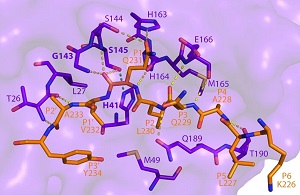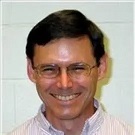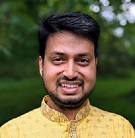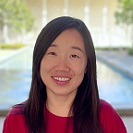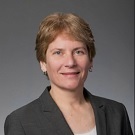SSRL-Related Science
Molecular Cage Protects Precious Metals in Catalytic Converters
Excerpt from SLAC News Article by Chris Patrick
Sometimes, solutions to environmental problems can have environmentally unfriendly side effects. For example, while most gas-powered cars have a catalytic converter that transforms engine emission pollutants into less harmful gases, this comes with a tradeoff: Catalytic converters contain precious metals such as platinum and palladium.
The good thing about these precious metals is that they act as catalysts that help break down pollutants, with a suite of properties that make them the best elemental candidates for this chemical job. But they are also rare, which makes them expensive, and extracting them from the earth produces its own pollution.
However, in a paper published October 24 in Nature Materials, researchers at SUNCAT and SSRL reported a way of encapsulating catalysts that could reduce the amount of precious metals catalytic converters need to work, which could in turn reduce the practice of precious metal mining. Read more...
SARS-CoV-2 Protein Caught Severing Critical Immunity Pathway
Excerpt from SLAC News Article by David Krause
Over the past two years, scientists have studied the SARS-CoV-2 virus in great detail, laying the foundation for developing COVID-19 vaccines and antiviral treatments. Now, for the first time, scientists from SLAC, Oak Ridge National Laboratory, and other institutions have seen one of the virus’ most critical interactions, which could help researchers develop more precise treatments.
The team caught the moment when a virus protein, called Mpro, cuts a protective protein, known as NEMO, in an infected person. Without NEMO, an immune system is slower to respond to increasing viral loads or new infections. Seeing how Mpro attacks NEMO at the molecular level could inspire new therapeutic approaches.
To see how Mpro cuts NEMO, researchers used x-rays from SSRL's Beamline 12-2 to reveal what Mpro looks like when it dismantles NEMO’s primary function of helping our immune system communicate. Read more...
Awards & Honors
Blaine Mooers Wins 2022 Lytle Award for Decades of Synchrotron Leadership and RNA Research
Excerpt from SLAC News Article by David Krause
Blaine Mooers, associate professor of biochemistry and molecular biology at the University of Oklahoma Health Sciences Center, has won this year’s Farrel W. Lytle Award for advancing synchrotron science and RNA editing research at SSRL.
Over his many years doing experiments at SSRL, Mooers has also galvanized the facility’s research community and spoken in support of SSRL at many national and international meetings, said Graham George, professor and Canada Research Chair at the University of Saskatchewan, and previous chair of the SSRL User Executive Committee (UEC).
“Blaine has been instrumental in organizing SSRL workshops, and has been an enthusiastic contributor to every recent SSRL/LCLS Users’ Meeting,” George said. “Not only that, he is an accomplished scientist with a growing track record of elegant research.” Read more...
Saket Bagde Wins 2022 Spicer Young Investigator Award for Deciphering how Nature Produces Some Antibiotics
Excerpt from SLAC News Article by Kimberly Hickok
When Saket Bagde made an early attempt in 2017 to use the beamlines at SSRL to determine the structure of a particularly tricky protein, SLAC scientist Irimpan Mathews was skeptical Bagde could do it. “I thought this poor student is not going to get any results,” Mathews said.
But as Mathews soon learned, Bagde is an exceptionally motivated scientist with a strong will to answer the toughest questions. His unwavering determination led Bagde to achieve a feat scientists had been trying to accomplish for more than 30 years: accurately visualizing the entire structure of a protein complex called polyketide synthase, a molecule used in the production of antibiotics and other drugs. For his efforts, Bagde has been awarded SSRL’s 2022 Spicer Young Investigator Award. Read more...
Chengcheng Fan Wins 2022 Klein Award for Coronavirus Vaccine and Protein Transporter Research
Excerpt from SLAC News Article by David Krause
Chengcheng Fan is not sure what she will be doing twenty years from now. But later in life, she wants to look back and say that she tried her hardest to help develop a more powerful coronavirus vaccine during the global pandemic.
So far, Fan is doing just that: She has mapped the structures of more than 30 antibodies attached to coronavirus spike proteins using cryo-electron microscopes at the California Institute of Technology Cryo-EM Center and high-brightness x-rays from SSRL's Beamline 12-2. Seeing antibodies bound to spike proteins is a key step in creating vaccines that can protect against a wider spectrum of coronavirus variants.
For her work, Fan received the prestigious Melvin P. Klein Scientific Development Award during the SSRL/LCLS Annual Users' Meeting and Workshops from Sept. 26 – 30. Read more...
2022 Nobel Prize in Chemistry
Carolyn Bertozzi, Stanford University, has won another award. The Royal Swedish Academy of Sciences has awarded the Nobel Prize to Bertozzi for "for the development of click chemistry and bioorthogonal chemistry.” She coined the term "bioorthogonal chemistry" herself for chemical reactions compatible with living systems.
Bertozzi, the Anne T. and Robert M. Bass Professor in the School of Humanities and Sciences and a professor of chemistry, with courtesy appointments in Chemical & Systems Biology and Radiology, has been honored with a number of other prestigious awards for her work. Most recently, the awards have included the 2022 Lifetime Mentor Award from the American Association for the Advancement of Science, the 2022 Wolf Prize in Chemistry, 2022 Lifetime Mentor Award from the American Association for the Advancement of Science and the 2022 Dr H.P. Heineken Prize for Biochemistry and Biophysics.
Since joining Stanford in 2015 Bertozzi's research has included the use of our SSRL and CryoEM facilities at SLAC. See Stanford News article
SSRL Users' Executive Committee Update
SSRL UEC 2022-2023 Membership
Please join us in supporting Blaine Mooers as the new SSRL Users' Executive Committee Chair. The Vice-Chair will be determined at the Committee's next meeting. We thank everyone who agreed to be nominated and extend a warm welcome to our newly elected members: Sarah Bowman, Woody Fischer, and Jake Pushie.
We would like to acknowledge the continuing contributions of Graham George, who rotates from SSRL UEC Chair to Past Chair. And, we would like to express our thanks to retiring committee members Rebecca Page, Angelia Seyfferth, and Tim Stemmler. For more information see SSRL's Users' Executive Committee (UEC).



